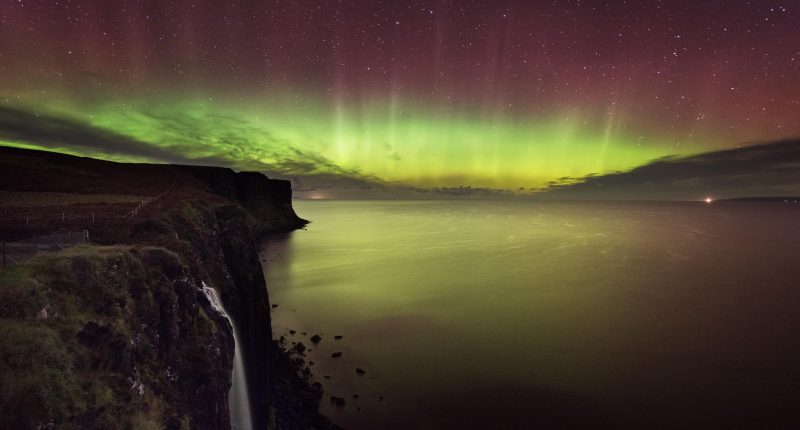THE Northern Lights are forecast to be visible from the UK tonight until the early hours of Saturday amid a minor geomagnetic storm that is hitting Earth.
The display could be seen as far south as Cornwall, just like last weekend’s event.
The same solar storm that brought Northern Lights to the UK a week ago may still have enough power to give Brits another sighting, according to the British Geological Survey (BGS).
In an update on their website, the BGS says geomagnetic activity will be active between 8 and 10 March.
“Some isolated ACTIVE periods over the last 24 hours have been attributed to a glancing blow from the Coronal Mass Ejection (CME) that lifted from the Sun on the 3rd of March,” the BGS writes.
“Modelling suggests that the bulk of the CME from the 5th of March is likely to miss Earth, however a glancing blow may bring enhancements early on the 9th of March.
READ MORE ON SPACE WEATHER
“Should the effects from this CME combine with the high-speed stream, there is a chance geomagnetic activity could increase up to STORM G1.”
A STORM G1 is a minor geomagnetic storm, which can cause some weak disruption to power grids.
Although Aurora Borealis – otherwise known as Northern Lights – are visible even during weak geomagnetic storms.
A geomagnetic storm is what happens inside Earth’s magnetosphere as a result of solar wind, or a CME.
Most read in Tech
How can I see the Northern Lights?
Firstly, it helps to be in an area with little light pollution.
Rural areas are best for sky gazing.
Auroral displays are most often seen further north, but stronger flares can move south, as spotted by those in Cornwall last night.
Sometimes, aurora can appear white to the human eye, so it can help to take a quick photo on your phone to help reveal the colours.
If you’re planning on photographing the aurora properly, you’ll need a DSLR or bridge camera and ideally a tripod.
Experts have also advised that hopeful watchers not be too disheartened if the aurora look dim at first.
This is because they usually brighten over the course of a few hours.
People should also stay vigilant, as the display can change quickly.
But it’s unpredictability is why the sight is firmly placed on the bucket lists of many.
More displays to come
There is set to be a big uptick in Northern Lights sightings from this year through to 2025.
This is because we are entering the sun’s Solar Maximum – when solar activity peaks during the sun’s 11-year solar cycle.
During this time, the sun produces “dramatically more” auroral displays, Darren Baskill, a physics and astronomy lecturer at Sussex University, explains.
The next high point had been forecast for July 2025.
However, the Solar Maximum will arrive earlier than expected, according to Nasa scientist Robert Leamon and Scott McIntosh, deputy director at the US National Centre for Atmospheric Research (NCAR).
They say the cycle’s peak will occur a year earlier – in mid-to-late 2024.
This means the best time of the decade to tick the Northern Lights off your bucket list is right around the corner.
Sunspots – which kick out solar flares that cause Northern Lights – will become twice as likely during the Solar Maximum, which lasts between three and five years.
During that time, the displays will appear more vibrant with red, pink and purple hues which are typically more rare than the green waves.
Sunspots, the black regions on the Sun’s surface, are particularly active areas that can ‘burp’ out solar wind in the Earth’s direction.
READ MORE SUN STORIES
When these streams of highly charged particles collide with the Earth’s magnetic field, they make the upper atmosphere glow.
This heightened era of activity is why humans are graced with such an epic sight.
Find out more about science
Want to know more about the weird and wonderful world of science? From the Moon to the human body, we have you covered…













